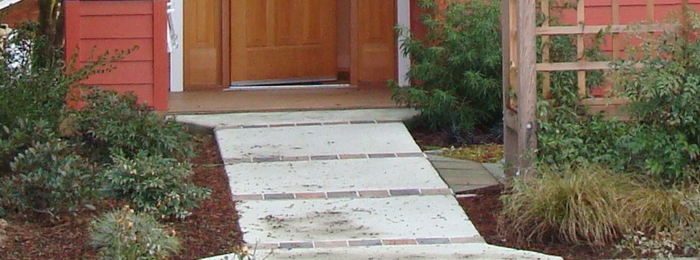|
By
Barb Manning
According to the United Cerebral Palsy’s State of Disability
there are 54 million people living with disabilities in America.
The United States has a generally aging population; 2005 Census
statistics indicate that there are 78.2 million aging Baby
Boomers in America. At any time, an individual can develop a
temporary disability. Unintentional falls are in the top ten of
the list of injuries leading to an emergency room visit or
hospitalization.
|

Photo By: Emory Baldwin |
|
“When someone builds a home, they’re not just building it for themselves — that home’s going to be around for a 100 years.” –Eleanor Smith, Founder of Concrete Change
|
What can an individual do after breaking a leg if they live in a
home with the bathroom on the second floor? They can seriously
limit their fluid intake and only use the bathroom once or twice
per day. What does an individual do if they break a hip? Every
year, thousands of Americans face this same question. It is not
enough for disability advocates to argue for Visitability on a
state-by-state basis. Visitability must become a national
priority. Too often individuals become prisoners in their homes
because they can’t safely navigate the steps. Visitability could
liberate millions of people living in isolation from their
friends, neighbors, and communities.
What is Visitability?
The Americans with Disabilities Act requires access for people
with disabilities for all new multi-family dwellings and a small
percentage (5%) of single-family homes constructed using public
funds. This law obviously does not address the vast majority of
single-family housing in the United States. Visitability seeks to make new housing accessible by having
it meet three basic conditions:
- hallways and doorways wide enough for safe navigation by
wheelchairs
- one zero-step entrance with a wheelchair approachable
route
- one wheelchair-accessible
bathroom on the main floor.
Just making these three changes in
the design of new homes is a cost-effective way for people to
maintain their independence. Most people living with a
disability will tell you that their biggest issue is living in a
world that does not consciously accommodate their needs. A lack
of easy access denies those who need it opportunities to
interact, socialize, create, and enjoy friendships.
Current Options?
For people with disabilities and the elderly, options are
available to help make a dwelling accessible, but these are
costly and time-consuming. Constructing an accessibility ramp in
Northwest Ohio can currently cost as much as $5,000 with the
cost of labor and materials factored in. Installing a
residential wheelchair lift onto a home can cost the homeowner
between $3,400 and $6,500. If an individual lives in Northwest
Ohio and can’t afford to construct a ramp, or install a lift,
they may be waiting on a list for 18 months for a social service
agency to meet their needs.
Entering a nursing home may be an option. According to the
Center for Disease Control and Prevention, there are 16,100
nursing homes in America with 1.7 million beds and 86%
occupancy. The number of current residents in 2004 was 1.5
million and the average stay was 835 days, a little over two
years. If individuals are only staying in nursing homes for
little more than 2.5 years, where are they going? For the most
part, they are returning to homes that do not meet their needs.
Individuals spend years residing in homes with dining rooms or
living rooms converted to bedrooms, using portable commodes, and
undergoing sponge baths. Is this how anyone wants to spend his
or her life?
A Better Way
“It defies logic to build new homes that block people out when
it’s so easy and cheap to build new homes that let people in.” —
Rep. Jan Schakowsky (D. -IL)
Designing homes with open floor plans, U-shaped kitchens with
maneuvering space for food preparation, bathrooms with
reinforced walls that support the installation of grab bars can
add value for everyone, not just the elderly and people with
disabilities. In March 2009, Representative Jan Schakowsky
re-introduced the Inclusive Home Design Act (HR 1408) to
Congress. For new homes built with federal assistance, this bill
supplements the existing 5% requirement of fully accessible
units by mandating visitability in all of the other units. If
this bill becomes law, it will make subtle, but substantial
changes in how America constructs new homes.
Visitability is an
important strategy for developing accessible housing. It can
contribute to creating neighborhoods and communities that
welcome everyone. There is a huge market of 78.2 million Baby
Boomers who may soon need affordable and accessible homes.
Comments:
http://blog.aipathome.com/should-visitability-be-a-federal-law/
|